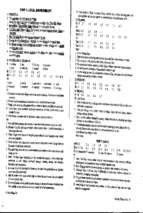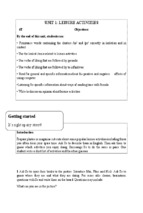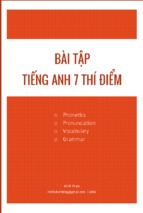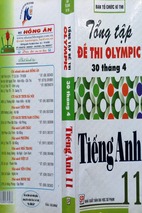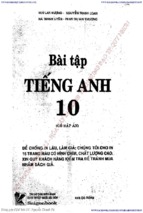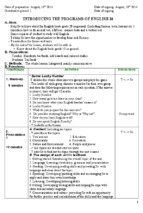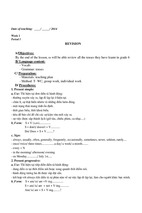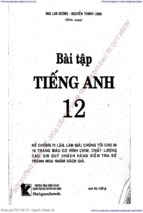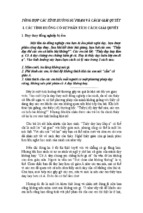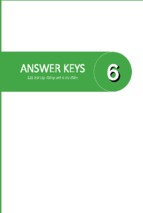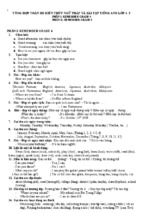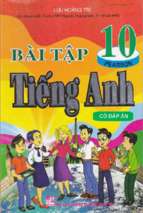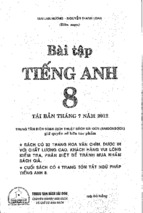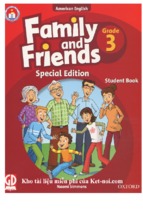FORMATIVE ASSESSMENT TO ENHANCE STUDENT PERFORMANCE
How does ongoing assessment encourage task participation and enhance learning
performance?
By Tran Dinh Quyet
What classroom techniques can help?
How do we mark student performance on the spot?
RATIONALE
Skill integration and on-the spot performance testing are the current teaching
approach adopted in Vietnam nowadays.
Greater focus and emphasis are being put on students’ communicative
performance in the language classroom.
Ongoing assessment serves various purposes. For the student, they can help attract their
attention, encourage learners to participate in tasks, build up their confidence and allow
them to assess themselves. For the teacher, they help you to access the extent to which
your students understand the course content and they can provide you with information
about the effectiveness of your teaching methods. Most are designed to be quick and
easy to use and each activity provides quick assessment for different skills and
competencies. ( Guskey, 2003)
Ongoing assessment provides formative evaluations of text books, teaching methods,
and, ultimately, student learning. Such formative evaluations are done frequently to
encourage learning and enhance performance as well as to effect immediate adjustments
in the day-to-day teaching. More and more classroom teachers incorporate continual
testing into everyday class session. ( Guskey, 2003)
REVIEW
How does ongoing assessment encourage task participation?
Below is a collection of implications suggested by several authors as cited in the
references.
Formative ongoing assessment in class …
Sets a competitive tone to the class to get to the top by awarding bonus marks
Provides the chance for team work and healthy cooperation
Helps to foster good working relationships ( Stiggins, 2002)
Provides instant feedback in forms of grades, formative correction and positive
comments
Reduces feelings of isolation and impotence, especially in large classes
Shows your interest and appreciation about their success in your classroom ( Barton,
2002)
Fosters an attitude that values understanding and initiatives in problem solving
Encourages students to understand that learning is an on-going process that require full
participation.
Enables you to record student progress and to assign on-the-spot marks
Saves your time for preparing tests or reading student papers. ( Bloom et al, 1981)
How does ongoing assessment enhance learning performance?
When OA is used frequently, it can have the following impacts:
Students learn when to work individually, in pairs or in groups for the utmost time and
cost efficiency.
Helps develop self-assessment and learning management skills
The various ongoing incentive assessment ensures the development of all-round
learning skills of critical analysis, creative synthesis as well as application and
performance. ( Stiggins, 2002)
Helps students to get prepared for a task, have an overview first and orientate
themselves before doing a task.
Students learn from others at work and make comparisons and contrasts.
Teaches learners how to work in a team for the best way to solve a problem ( Barton,
2002)
Students learn how to initiate, ask for help from peers and teachers, discuss a problem
and come to a solution
Students learn how to present and discuss a problem in a group and in front of the class.
Students learn about time efficiency and how to make a good presentation. ( Bloom et
al, 1981)
Students discover on the spot what they have learnt and can do and what they cannot do
yet.
Students get instant feedback about their misconceptions or lack of understanding in a
timely way
METHODOLOGY
There are 2 experimental classes and 2 control classes of grade 10
Classes 10A2 and 10A13 are experimental classes paired with the control ones of 10A3
and 10A14. All these four classes are of the same level of proficiency and consist of allability students.
Table 1. Comparison of first and second term papers results.
Term 1. average or higher
Term 2. average or
higher
Experimental
65%
83%*
10A13 Experimental
60%
70%*
10A3
Control
60%
62%
10A14
Control
51%
54%
10A2
Table 2. Comparison of first and second terms score average.
Term 1
Term 2
Experimental
70%
85%*
10A13 Experimental
64%
72%*
10A3
Control
62%
64%
10A14
Control
55%
57%
10A2
Observations and records of mark improvement from semester 1 to semester 2
Observations of grade improvement are done on the basis of comparing the
improvement in grade scores of the two experimental classes with those grades of all
the other classes.
Table 3. Comparison of speaking test scores in term 1 and term 2
Term 1
Term 2
10A2
70%
85%*
10A13
62%
73%*
Table 4. Percentage of Active participants and Confident presenters recorded
during class observations
Term 1
Term 2
10A2
67%
81%*
10A13
60%
73%*
Following is a partial chart of OA tasks I used on daily basis, showcasing a variety
of teacher work and student task in each stage of a particular class session based
on the text books currently used in Vietnam.
SET 1. For the reading session
READING
TEACHER WORK
STUDENT WORK / TASK
TYPES
Leading in
Set the situation and
5 min. Class-
communication
Briefing
needs
1. Describe pictures to the class
Where / When / Who / What /
How
5 min.
Presentation
Activate topic-based
useful expressions
2. Brainstorm global questions:
A topic to discuss or a problem to
deal with
3. Practice useful expressions before
reading
Topic-based vocabulary
4. Explain word meaning
Using situations and paraphrasing
Skim-reading Get students read for
1. Survey the title, skim paragraph 1
5 min. Pair-
gist: topics,
and predict the central idea of the
share
paragraph points and
passage.
5 min.
organization
2. Skim the whole passage, look for
Presentation
Keep class
the topic sentence of each subsequent
communication
paragraph and find out the main point
going
that the writer makes.
3. Think aloud, telling your partner
about the main points of the article.
Scan-reading Engage students in
1. Scan specific parts of the article to
5 min. Pair-
interesting detailed
answer given questions. Check with
share
game-like
your partner and support your
5 min.
information and
answers by answering the question
Presentation
quiz-like inferential
‘How can you tell?. Say in paragraph
questions
X, line Y, it reads / says …
2. Answer some text-based
Keep students
working and give
interesting questions. Inferential
questions get you to start thinking
support where
logically and trying to express your
relevant
ideas and make yourself understood.
3. Time efficiency, logical thinking
and expressing oneself are the main
sub-skills to practice with game-like
or quiz-like scan-reading.
Reclaim the lesson
Summarizing
aims (content and
1. Complete this table / spider-
5 min. Class-
language) and check
diagram with keys words and phrases
share
with students
from the text.
5 min.
whether the aims are
( Content summary and Language
Presentation
achieved
awareness are central to this stage of
Over-to-you
reading)
wrapping up: What
2. Pick out useful expressions from
would you do in the
the article that mean …
same situation?
3. How would you put / say it another
way?
4. What would you do in a similar
situation?
SET 2. For the speaking class
SPEAKING Prepare pictures of a target
1. Describe the pictures with
Snapshot
the given topic vocabulary
5 min. Pairshare
language function.
Think of useful expressions
and collocations for the
2. Imagine what people would
say in that situation with
5 min.
target communication
given useful expressions.
Presentation
situation
3. Match common
collocations
Prepare a sample dialogue
1. Listen to the dialog and
Setting
Think of situation questions
then ask and answer the
situation
Think of comprehension
questions
5 min. Pair
questions
2. Practice the dialog with
share
appropriate intonation and
5 min.
‘feeling’ gambits and
Presentation
interjections.
Pick out the main function
1. Ask students to sort out the
Language
and communication needs of
sentences that perform the
function
the sample dialog.
main language function, say, ‘
5 min. Pairshare
5 min.
Presentation
Call students’ attention to
What does Jane say to advise
target language functions
Tom about how to keep fit?’
Prepare some typical
conversational exchanges
2. Complete some exchanges
with gaps for appropriate
with appropriate questions or
responses
responses.
Prepare some change in facts
Role playing
and figures for simulation
1. Practice a similar dialog
with some change in facts and
5 min. Pair
Assign roles to interlocutors
figures with sensible back-
share
Provide an outline and key
channeling and turn taking.
5 min.
notes for a small talk
2. Give a short talk with an
Presentation
outline and key words and
phrases and expand the
answer to a reasonable extent.
SET 3. For the Listening session
Situation and Set the background situation
1. Work in pairs / groups
language
discussing the situation and
5 min. Pairshare
Who / where / what
Introduce some key words
the need to communicate
and phrases
5 min.
2. Predict the answers / what
Presentation
speakers say in that situation
Prepare task 1 by listening
Listening for
for gist yourself and find out
1. Listen for general topics or
gist
what is central to the
ideas: What are they talking
5 min. Indi.
recording.
about?
work
Prepare a framework or
5 min.
scaffolding for students to
2. Present the main points
Presentation
present the main ideas.
with a given framework
Prepare task 2 for detail
Listening for
details
5 min. Pair-
listening, sub-skill 1
Prepare task 2 for detail
listening, sub-skill 2
1. Listen for specific
important details: where /
when / how / why
2. Listen for some interesting
share
Prepare a framework or
facts / expressions:
5 min.
scaffolding for students to
“Time and tide wait for no
Presentation
present the classified details.
_______.”
3. Present the details and facts
you hear in your own words.
Prepare a framework or
1. Answer some round-off
Summarizing
scaffolding for students to
questions from your teacher
5 min. Pair-
present an oral summary of
2. Report today’s story
share
the content
5 min.
Presentation
SET 4. For the writing class
Call students’ attention to a
1. Discuss the situation and
Sampling an
situation or a communication
the need to communicate.
outline
event.
2. Study the sample and
5 min. Pairshare
5 min.
Presentation
Have students get access to a
sample piece of writing.
Have students work out a
typical outline.
Set a similar communication
Brainstormin
g
situation
Have students brainstorm the
answer some questions about
text organization
3. Work out an outline with a
given frame
1. Discuss a similar situation
in pairs or groups
2. Brainstorm and note down
5 min. Pair-
ideas and jot down key
share
words within the outline.
ideas in a flow chart
5 min.
Presentation
Allow time for individual
Writing
practice
5 min. Indi.
1. Individual free writing
free writing
Have some students present
their own writing orally
2. Present the writing in oral
speech
work
5 min.
Presentation
Have pairs share their own
Editing
5 min. Pair-
1. Edit your writing in pairs
work and edit.
Have a student present his /
share
her writing on the board for
5 min.
class editing.
2. Present your complete
writing on a flip board.
Presentation
SET 5. For language focus lessons
Enable students to work out
Pronunciatio
n
the pattern
Have students practice the
1. Work out a phonetic
pattern
5 min. Pair-
target pronunciation and find
2. Practice the pattern in
share
out more from prior
context
5 min.
knowledge
Presentation
Raise awareness of word
Vocabulary
in use
5 min. Pair-
formation
Raise awareness of word
partnership
1. Practice ONE derivative at
a time:
The –ion noun / The – tive
adjective
share
2. Match collocation halves or
5 min.
complete common verb /
Presentation
noun phrases.
Grammar for a particular
Grammar in
use
communication need / event.
Set a situation and
1. Learn about the use or
function in communication of
the target grammar point.
5 min. Pair-
framework for
2. Practice pairs of
share
conversational grammar
conversational exchanges
5 min.
practice.
with the target
Presentation
5 min. Pair-
Prepare a Listen-and-
communication function.
respond exercise
share
5 min.
Presentation
Attract attention to common
1. Practice some special
Language
patterns in pronunciation,
cases, especially those from
awareness
grammar and vocabulary
students’ prior knowledge.
5 min. Pairshare
Call attention to notable
exceptions in common use
2. Complete some rules in
grammar and vocabulary.
5 min.
Presentation
IV. Some useful well-trialed classroom techniques
( University of Oregon, Spring 2014. Ways to assess students in the classroom: TEP
http://tep.uoregon.edu )
ETS ( 2013). Linking classroom assessment with student learning: www.ets.org)
1. Think-Pair-Share – ( Task time: 5 to 15 minutes / Group size: 2-3)
For the speaking – writing class
Take a hot topic in the community that is related to the lesson and have students reflect
on it individually and then discuss it further
Think phase: Students work independently and note down their thoughts/arguments
Pair phase: Students discuss their response with a partner
Share phase: Elicit responses from all members of the class and ask students to explain
their ideas.
2. Round Robin – (Task time: 5 to 15 minutes / Group size: 4 to 6)
Pre-reading / Pre-listening / Post reading / Post listening activities.
To practice vocabulary – topic-related key words
Small groups of students are engaged in key-word brainstorming
Each student takes turns to say one word or phrase surrounding a central concept or
topic
The next person is given the opportunity to add a word or phrase to the list
Each group can list their four to six main thoughts as a means of discussing and
summarizing the topic.
The activity concludes after all members have participated in presenting their thoughts
to the class.
3. IF-AT Cards (Immediate Feedback Assessment Technique.)
(Task time: 5 to 10 minutes / Group size: 3-5)
For language focus or revision classes after a chapter or before a major test or
examination
IF-AT cards function like multiple choice questions. A group of learners answer the
question out of their knowledge and then they scratch the card to reveal the correct
answer.
Students can begin by answering the list of questions on their own without using an IFAT card.
Afterwards, students work with a group to go through the questions, convince one
another of the correct answer, and then scratch the card to uncover what is right.
Ideally used to provide immediate feedback to students about concepts related to the
target lesson.
4. Fishbowl discussion
(Task Time: 15 to 20 minutes / Group size: 3 to 5 inside, remaining class outside of
circle)
For the speaking class or pre-writing and post writing activities.
Small group of students sit in a circle or around a desk and engage in a peer-mediated
discussion
(with the teacher’s intervention as required)
Remaining students sit in a larger outward circle and watch the discussion, taking notes
and critiquing the content and logic of the discussion
The outer circle can then discuss the interaction of content that has just occurred and
provide additional insight into the topic and provide constructive feedback
5. Simulation / Role Play – (Task Time: 15 to 20 minutes / Group size: 2 to 5)
Ideally for conversational practice in everyday communication.
Simulation comes first, where learners play character parts saying their exact ‘words’ as
in the sample dialog and experience their ‘feelings’.
Role play follows to demonstrate varying perspectives on a topic. In role play students
can play a role from different view points, which give them chance to apply to real life
situation as well as to practice their English creative and natural manner.
Students assume different roles in small groups and act out the parts with the varying
perspectives they would have.
6. Think-Aloud Pair-share Problem Solving – (Task Time: 15 to 20 minutes / Group
size: 2)
For all classes that involve students in a discussion
For the speaking class / After you read or listen / Before you write
Present students with a realistic problem that requires multiple steps to solve.
Pair up students and ask them to discuss an effective strategy and develop a practical
solution.
The partners listen to each other and offer suggestions if there are difficulties, or
expresses confusion should there be difficult parts to understand.
After the first problem has been solved, ask the students to switch roles and begin again
V. FINDINGS AND RESULTS
Findings have shown that implementation of formative assessment in the two
experimental classes led to numerous encouraging results as follows
> Greater student participation and performance
> Considerable grade improvement compared with control classes
> Greater students’ confidence, satisfaction and self-fulfillment
> More time saving and cost efficiency on teacher’s part
E. RECOMMENDATIONS AND CONCLUSIONS
Marking schemes:
Whether it is pair work or group work, written or spoken form, marking is based on
individual performance.
Marking is done on the spot and promotion bonus is based on each individual’s
progress and effort for the greatest motivation.
A small difference in marks given to group members, say 0.25 point, really counts for
them, so that they could compare with each other.
Second chance bonus policy is adopted so that students are never discouraged from
making efforts and getting over themselves all the time.
Assessment is done at random, not in the order of the name list, so that students get to
learn that they just work hard and testing will come naturally.
Assessment should be done holistically, i.e. overall performance in communication is
measured, not discreet points.
Be flexible
Add spices and more variety
Holistic marking and second chance bonus policy should always be adopted.
F. REFERENCES AND SUGGESTED READINGS
Barton, P. E. (2002). Staying on course in education reform. Princeton, NJ: Statistics
& Research Division, Policy Information Center, Educational Testing Service.
Bloom, B. S., Madaus, G. F., & Hastings, J. T. (1981). Evaluation to improve
learning. New York: McGraw-Hill.
Guskey, T. R. (2000b). Evaluating professional development. Thousand Oaks, CA:
Corwin Press.
Kifer, E. (2001). Large-scale assessment: Dimensions, dilemmas, and policies.
Thousand Oaks, CA: Corwin Press.
Stiggins, R. J. (1999). Evaluating classroom assessment training in teacher education
programs.Educational Measurement: Issues and Practice, 18(1), 23–27.
Stiggins, R. J. (2002). Assessment crisis: The absence of assessment for learning. Phi
Delta Kappan, 83(10), 758–765.
Wiggins, G. (1998). Educative assessment. San Francisco: Jossey-Bass.
University of Oregon, Spring 2014. Ways to assess students in the classroom: TEP
http://tep.uoregon.edu )
ETS ( 2013). Linking classroom assessment with student learning: www.ets.org)
Implemented by TRAN DINH QUYET, 2015
THONG NHAT HIGH SCHOOL, DONG NAI
THE END
Recommended Further reading
How Classroom Assessment Improves Learning
“Teachers who develop useful assessments, provide
corrective instruction, and give students second
chances to demonstrate success can improve their
instruction and help students learn.”
Thomas R. Guskey
Teachers who develop useful assessments, provide corrective instruction, and give
students second chances to demonstrate success can improve their instruction and help
students learn.
Large-scale assessments, like all assessments, are designed for a specific purpose.
Those used in most countries today are designed to rank-order schools and students for
the purposes of accountability—and some do so fairly well. But assessments designed
for ranking are generally not good instruments for helping teachers improve their
instruction or modify their approach to individual students. First, students take them at
the end of the school year, when most instructional activities are near completion.
Second, teachers don't receive the results until two or three months later, by which time
their students have usually moved on to other teachers. And third, the results that
teachers receive usually lack the level of detail needed to target specific improvements
(Barton, 2002; Kifer, 2001).
The assessments best suited to guide improvements in student learning are the tasks,
quizzes, tests, writing assignments, and other assessments that teachers administer on a
regular basis in their classrooms. Teachers trust the results from these assessments
because of their direct relation to classroom instructional goals. Plus, results are
immediate and easy to analyze at the individual student level. To use classroom
assessments to make improvements, however, teachers must change both their view of
assessments and their interpretation of results. Specifically, they need to see their
assessments as an integral part of the instruction process and as crucial for helping
students learn.
Despite the importance of assessments in education today, few teachers receive much
formal training in assessment design or analysis. A recent survey showed, for example,
that fewer than half the states in the whole United States require competence in
assessment for licensure as a teacher (Stiggins, 1999). Lacking specific training,
teachers rely heavily on the assessments offered by the publisher of their textbooks or
instructional materials. When no suitable assessments are available, teachers construct
their own in a haphazard fashion, with questions and essay prompts similar to the ones
that their teachers used. They treat assessments as evaluation devices to administer
when instructional activities have been completed and to use primarily for assigning
students' grades.
To use assessments to improve instruction and student learning, teachers need to change
their approach to assessments in three important ways as follows
Make Assessments Useful
For Students: Nearly every student has suffered the experience of spending hours
preparing for a major assessment, only to discover that the material that he or she had
studied was different from what the teacher chose to emphasize on the assessment. This
experience teaches students two un-fortunate lessons. First, students realize that hard
work and effort don't pay off in school because the time and effort that they spent
studying had little or no influence on the results. And second, they learn that they
cannot trust their teachers (Guskey, 2000a). These are hardly the lessons that
responsible teachers want their students to learn.
Nonetheless, this experience is common because many teachers still mistakenly believe
that they must keep their assessments secret. As a result, students come to regard
assessments as guessing games, especially from the middle grades on. They view
success as depending on how well they can guess what their teachers will ask on
quizzes, tests, and other assessments. Some teachers even take pride in their ability to
out-guess students. They ask questions about isolated concepts or obscure
understandings just to see whether students are reading carefully. Generally, these
teachers don't include such “gotcha” questions maliciously, but rather—often
unconsciously—because such questions were asked of them when they were students.
Classroom assessments that serve as meaningful sources of information don't surprise
students. Instead, these assessments reflect the concepts and skills that the teacher
- Xem thêm -

